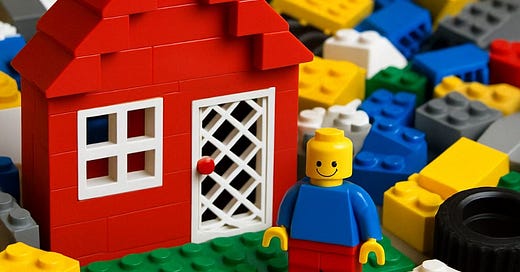On simplicity, complexity, and how play reveals powerful truths about business
Somewhere in a cupboard or attic, many of us still have a box of LEGO. I know I do. A scatter of plastic bricks that never truly disappears, that calls out to be rebuilt, reimagined, reshaped.
And yet LEGO is far more than a nostalgic brand. It is one of the most successful and resilient companies of the modern era. From near-bankruptcy in the early 2000s to becoming the world’s most valuable toy brand, LEGO's journey is a case study in adaptability, purpose, and deep complexity thinking.
There’s much we can learn from LEGO’s story. Not just about product innovation or branding, but about how organisations build structures that last—and how the best systems are often the simplest ones.
The Power of a Clear System
At the heart of LEGO’s enduring appeal is an elegantly simple system: interlocking bricks, consistent dimensions, universal compatibility. A LEGO brick made today will still fit one made in 1958.
This standardisation is not a constraint; it is a superpower. It allows infinite variety from a limited set of components. It invites creativity while maintaining coherence. It provides both freedom and form.
Organisations that thrive over time often do the same. They create modular systems that scale, that allow for local variation within a global frame. They know where consistency matters—and where it doesn’t.
LEGO doesn’t reinvent the brick with every set. Nor should we reinvent every process, every role, every governance model. The challenge is to get the system right—and then let people build upon it.
Simplicity that Invites Complexity
What makes LEGO brilliant isn’t just that it’s simple. It’s that it invites complex outcomes. Children (and adults) build everything from castles to robots, cities to spaceships, all from a limited vocabulary of parts.
In organisations, we often confuse complexity in design with sophistication. We build processes with ten stages when three would do. We add governance layers to show we are serious. We assume that more is better.
But real sophistication is in creating simplicity that scales. Simplicity that invites ownership. Simplicity that makes it easy to see when something isn’t working.
A Culture of Imagination and Discipline
LEGO balances two forces: play and precision. The bricks must be manufactured to exact tolerances. But the use of them is open-ended.
This duality is key to organisational success. Companies need structures that are precise enough to work reliably—but not so rigid that they stifle innovation.
At LEGO, imagination is embedded in the culture. But it’s also disciplined. New sets go through rigorous testing. Themes are carefully curated. Even LEGO Ideas—where fans submit concepts for new sets—follows a clear process.
It’s a reminder that creativity and structure are not opposites. They are partners.
CONTEXT - A Near-Collapse in Billund…
In the early 2000s, LEGO found itself teetering on the edge. Despite decades of global success, the company was haemorrhaging money—losing nearly $300 million in 2003 alone. It had expanded too far, too fast: from theme parks and video games to clothing lines and television content. The once-iconic brand had lost sight of its foundation.
It was then that Jørgen Vig Knudstorp, a former McKinsey consultant turned company insider, was appointed CEO. Just 35 years old at the time, he made bold decisions: selling off non-core assets, halting new product lines that didn’t fit the brand’s DNA, and, most crucially, returning the company’s focus to the brick. “We had become too clever,” he later remarked. “We forgot what we were best at.”
That refocus—on what LEGO alone could do—marked the start of one of the most remarkable corporate turnarounds in recent memory.
From Crisis to Clarity
Indeed, LEGO’s turnaround in the early 2000s wasn’t a fluke. It was the result of re-focusing. The company had over-extended—into video games, theme parks, TV shows, fashion. The core had been forgotten.
The recovery came through clarity: a return to the brick, to the system, to the idea that simplicity powers creativity. Leadership stopped chasing everything and started saying no.
This is a familiar pattern in organisations. Growth creates bloat. Urgency becomes distraction. And only a crisis brings the discipline to focus again.
But what if we didn’t wait for crisis? What if we used the LEGO metaphor to ask: what is the core system we build on? What are the bricks we need to protect?
Lessons for Leadership
LEGO doesn’t succeed because it has one big idea. It succeeds because it has *a system of ideas* that connect. And this is a powerful lesson for leaders.
Create modularity: Not every part of the business needs to look the same. But they need to connect.
Prioritise clarity: People don’t build from confusion. Give them simple, shared standards.
Balance freedom and form: Let people imagine their own solutions—within a frame that ensures coherence.
Return to the core: Regularly.
Final Thought: Rebuildable by Design
Perhaps the most profound lesson from LEGO is this: everything is designed to come apart.
A LEGO masterpiece is not permanent. It’s meant to be taken apart and rebuilt. This, too, is how resilient organisations operate. They build with the assumption of change. They embrace the idea that being rebuildable is not a flaw—it’s a strength.
In times of change, we would do well to remember the quiet wisdom of the brick:
“Make it simple. Make it fit. And leave room for imagination.”





